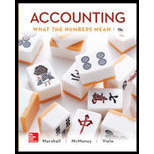
1.
Concept Introduction:
Contribution Margin-
Contribution margin can be defined as the difference between sales and variable costs. The portion i.e. left after deducting variable costs of the product from the sales, it is termed as contribution margin.
Contribution margin is a cost accounting concept which helps company to identify the profit earned on a single product.
It is measured by deducting variable costs from selling price.
Contribution margin ratio:
Contribution margin is the difference between sales and the variable cost. Contribution margin ratio can be defined as the difference between sales and variable cost expressed as the percentage of sales.
Variable costs:
Variable costs can be defined the cost or the expenses that change with the change in the level of output.
Fixed costs:
Fixed costs can be defined as the cost or the expenses that do not change with the change in the level of output.
To calculate:
Missing amounts for Firm A
2.
Concept Introduction:
Contribution Margin-
Contribution margin can be defined as the difference between sales and variable costs. The portion i.e. left after deducting variable costs of the product from the sales, it is termed as contribution margin.
Contribution margin is a cost accounting concept which helps company to identify the profit earned on a single product.
It is measured by deducting variable costs from selling price.
Contribution margin ratio:
Contribution margin is the difference between sales and the variable cost. Contribution margin ratio can be defined as the difference between sales and variable cost expressed as the percentage of sales.
Variable costs:
Variable costs can be defined the cost or the expenses that change with the change in the level of output.
Fixed costs:
Fixed costs can be defined as the cost or the expenses that do not change with the change in the level of output.
To calculate : Missing amounts for Firm B
3.
Concept Introduction:
Contribution Margin-
Contribution margin can be defined as the difference between sales and variable costs. The portion i.e. left after deducting variable costs of the product from the sales, it is termed as contribution margin.
Contribution margin is a cost accounting concept which helps company to identify the profit earned on a single product.
It is measured by deducting variable costs from selling price.
Contribution margin ratio:
Contribution margin is the difference between sales and the variable cost. Contribution margin ratio can be defined as the difference between sales and variable cost expressed as the percentage of sales.
Variable costs:
Variable costs can be defined the cost or the expenses that change with the change in the level of output.
Fixed costs:
Fixed costs can be defined as the cost or the expenses that do not change with the change in the level of output.
To calculate:
Missing amounts for Firm C
4.
Concept Introduction:
Contribution Margin-
Contribution margin can be defined as the difference between sales and variable costs. The portion i.e. left after deducting variable costs of the product from the sales, it is termed as contribution margin.
Contribution margin is a cost accounting concept which helps company to identify the profit earned on a single product.
It is measured by deducting variable costs from selling price.
Contribution margin ratio:
Contribution margin is the difference between sales and the variable cost. Contribution margin ratio can be defined as the difference between sales and variable cost expressed as the percentage of sales.
Variable costs:
Variable costs can be defined the cost or the expenses that change with the change in the level of output.
Fixed costs:
Fixed costs can be defined as the cost or the expenses that do not change with the change in the level of output.
To calculate:
Missing amounts for Firm C
Want to see the full answer?
Check out a sample textbook solution
Chapter 12 Solutions
Accounting: What the Numbers Mean
- Can you solve this general accounting problem with appropriate steps and explanations?arrow_forwardI am trying to find the accurate solution to this general accounting problem with the correct explanation.arrow_forward← Week 1: Homework Question 3 of 4 8.75/10 The project is completed in 2025, and a successful patent is obtained. The R&D costs to complete the project are $113,000. The administrative and legal expenses incurred in obtaining patent number 472-1001-84 in 2025 total $16,000. The patent has an expected useful life of 5 years. Record the costs for 2025 in journal entry form. Also, record patent amortization (full year) in 2025. (Credit account titles are automatically indented when amount is entered. Do not indent manually. If no entry is required, select "No Entry" for the account titles and enter O for the amounts. List all debit entries before credit entries.) Account Titles and Explanation Research and Development Expense Cash (To record research and development costs) Patents Cash (To record legal and administrative costs) Amortization Expense Patents (To record one year's amortization expense) Debit 113000 16000 3200 Credit 113000 16000 3200arrow_forward

 AccountingAccountingISBN:9781337272094Author:WARREN, Carl S., Reeve, James M., Duchac, Jonathan E.Publisher:Cengage Learning,
AccountingAccountingISBN:9781337272094Author:WARREN, Carl S., Reeve, James M., Duchac, Jonathan E.Publisher:Cengage Learning, Accounting Information SystemsAccountingISBN:9781337619202Author:Hall, James A.Publisher:Cengage Learning,
Accounting Information SystemsAccountingISBN:9781337619202Author:Hall, James A.Publisher:Cengage Learning, Horngren's Cost Accounting: A Managerial Emphasis...AccountingISBN:9780134475585Author:Srikant M. Datar, Madhav V. RajanPublisher:PEARSON
Horngren's Cost Accounting: A Managerial Emphasis...AccountingISBN:9780134475585Author:Srikant M. Datar, Madhav V. RajanPublisher:PEARSON Intermediate AccountingAccountingISBN:9781259722660Author:J. David Spiceland, Mark W. Nelson, Wayne M ThomasPublisher:McGraw-Hill Education
Intermediate AccountingAccountingISBN:9781259722660Author:J. David Spiceland, Mark W. Nelson, Wayne M ThomasPublisher:McGraw-Hill Education Financial and Managerial AccountingAccountingISBN:9781259726705Author:John J Wild, Ken W. Shaw, Barbara Chiappetta Fundamental Accounting PrinciplesPublisher:McGraw-Hill Education
Financial and Managerial AccountingAccountingISBN:9781259726705Author:John J Wild, Ken W. Shaw, Barbara Chiappetta Fundamental Accounting PrinciplesPublisher:McGraw-Hill Education





